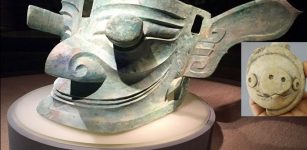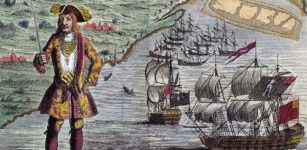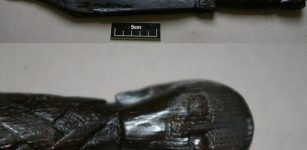Famous Viking Warrior Eric “Bloodaxe” Haraldsson: King Of Norway
A. Sutherland - AncientPages.com - Erik Haraldsson (885 - 954), nicknamed Eric Bloodaxe, was a 10th-century Norwegian ruler. He is thought to have had short-lived terms as King of Norway and twice as King of Northumbria (c. 947–948 and 952–954).
Erik Bloodaxe ("Blodyxa") was the oldest son of Harald (c.860 - c. 940), the first king to claim sovereignty over all of Norway, who ruled his country as a fair and powerful king for over 50 years. He was the greatest king in Norwegian history, respected as the father of his people, and a dominant figure of the Viking Era.
The Icelandic sagas say that Harald Fairhair had 20 sons, but his kingdom was somewhat limited and insufficient to provide a legacy for so many sons.
However, many of the details of Harald's reign are cloaked in mythology and folklore, and Erik's historical records are strikingly obscure. Legendary depictions in the kings' sagas differ, where Eric takes part in the tales of his father, Harald Fairhair, and his younger half-brother Haakon the Good.

Silver Penny of Eric Bloodaxe. Image source - source - British Museum
It is said that Erik secured his importance by gradually killing all his brothers. These actions probably´gave him his nickname "Bloodaxe"; in one of the Latin texts dated to the 1200s, Erik is called "fratris interfector" - brother killer.
Erik's reign in Norway was hard and unpopular, and his royal power was challenged by his one surviving, younger half-brother Hakan, who is said to have grown up in England at King Aethelstan's Court.
Hakan sailed to Norway to claim their inheritance, and Erik fled to England, where he was occupied with raids in Scotland and around the Irish Sea. Ancient tales say Athelstan welcomed him because of the friendship between his father, Harald Fairhair and Athelstan, who appointed him ruler of the Viking kingdom of Jorvik Northumbria.
However, the English and Irish sources – disagree. According to the Anglo-Saxon Chronicle and various Irish chronicles, Erik became King of Northumbria (c. 947- 94). It was several years after the death of Athelstan. Still, a later chronicle of William of Malmesbury mentions diplomatic relations between Athelstan and Harald Fairhair that fit with the fairy tale tradition.
Erik was briefly mentioned in several contemporary or near-contemporary sources; there is also his depiction on a coin issued in his name in York. However, available historical data about this Viking warrior is very scant.
He is mentioned in ancient Norwegian stories and Icelandic sagas, which identify Eric of Northumbria as a son of the Norwegian king Harald (I) Fairhair and, in many fairy tales, often with his wife Gunhild, portrayed as an evil witch. Ancient sagas use his nickname: "Blodyxa" (Bloodaxe) and describe him as a typical, violent Viking warrior.
The English and Icelandic sources say that Erik was killed in a battle. Erik was accompanied on this occasion by the five kings from the Hebrides and the two earls of Orkney.
Later sources, however, tell us that Erik was killed in an ambush on the desolate Stainmore, on the border of Cumbria, County Durham, and North Yorkshire.
Written by – A. Sutherland AncientPages.com Staff Writer
Updated on January 4, 2023
Copyright © AncientPages.com All rights reserved. This material may not be published, broadcast, rewritten or redistributed in whole or part without the express written permission of AncientPages.com
Expand for referencesReferences:
More From Ancient Pages
-
 Old Clay Pig Figurine And A 5,000-Year-Old Settlement Found Near Mysterious Sanxingdui Ruins, China
Archaeology | Jul 30, 2020
Old Clay Pig Figurine And A 5,000-Year-Old Settlement Found Near Mysterious Sanxingdui Ruins, China
Archaeology | Jul 30, 2020 -
 Stone Age Infants Received Care For Nine Hours Per Day From Up To 15 Different Caregivers – Study Informs
Archaeology | Nov 15, 2023
Stone Age Infants Received Care For Nine Hours Per Day From Up To 15 Different Caregivers – Study Informs
Archaeology | Nov 15, 2023 -
 Bartholomew Roberts Was Forced To Become A Pirate
Featured Stories | Aug 20, 2019
Bartholomew Roberts Was Forced To Become A Pirate
Featured Stories | Aug 20, 2019 -
 Significance Of Secret And Powerful Number 108 That Has Accompanied Humankind For Thousands Of Years
Ancient Symbols | Jun 19, 2017
Significance Of Secret And Powerful Number 108 That Has Accompanied Humankind For Thousands Of Years
Ancient Symbols | Jun 19, 2017 -
 Ancient Secrets Of The Amazon Jungle – Dangerous Expeditions And Hidden Treasures – Part 1
Featured Stories | Mar 1, 2019
Ancient Secrets Of The Amazon Jungle – Dangerous Expeditions And Hidden Treasures – Part 1
Featured Stories | Mar 1, 2019 -
 Mirpur Jain Temple: Stunning Artwork Of Ancient Craftsmen Of India
Featured Stories | May 17, 2021
Mirpur Jain Temple: Stunning Artwork Of Ancient Craftsmen Of India
Featured Stories | May 17, 2021 -
 Why Was Louis XIV Called The Sun King?
Ancient History Facts | Jul 11, 2019
Why Was Louis XIV Called The Sun King?
Ancient History Facts | Jul 11, 2019 -
 500-Year-Old Vaishnava Saint Sculptures Discovered
Archaeology | Oct 15, 2015
500-Year-Old Vaishnava Saint Sculptures Discovered
Archaeology | Oct 15, 2015 -
 Inca Llajta: Largest And Most Impressive Inca Complex In Bolivia
Civilizations | Dec 6, 2018
Inca Llajta: Largest And Most Impressive Inca Complex In Bolivia
Civilizations | Dec 6, 2018 -
 Why Did Sages And Shamans Repeatedly Visit The Mysterious Finnish Pirunkirkko Cave (Devil’s Church)?
Archaeology | Nov 27, 2023
Why Did Sages And Shamans Repeatedly Visit The Mysterious Finnish Pirunkirkko Cave (Devil’s Church)?
Archaeology | Nov 27, 2023 -
 Remains Of A 2,200-Year-Old Roman Fountain Discovered In Assos, Turkey
Archaeology | Aug 17, 2022
Remains Of A 2,200-Year-Old Roman Fountain Discovered In Assos, Turkey
Archaeology | Aug 17, 2022 -
 Secrets Of An Unusual And Mysterious Medieval Danish Axe Revealed By Scientist
Archaeology | Nov 25, 2022
Secrets Of An Unusual And Mysterious Medieval Danish Axe Revealed By Scientist
Archaeology | Nov 25, 2022 -
 Mysterious 9,000-Year-Old Shaman Burial In Bad Dürrenberg – One Of Central Europe’s Most Spectacular Archaeological Discoveries
Featured Stories | Sep 15, 2023
Mysterious 9,000-Year-Old Shaman Burial In Bad Dürrenberg – One Of Central Europe’s Most Spectacular Archaeological Discoveries
Featured Stories | Sep 15, 2023 -
 Ancient Tell-Tayinat Inhabitants And Climate Change Resilience – New Study
Archaeology | Oct 30, 2020
Ancient Tell-Tayinat Inhabitants And Climate Change Resilience – New Study
Archaeology | Oct 30, 2020 -
 Eastern Necropolis Of Ancient Thracian And Roman City Of Serdica – Unearthed
Archaeology | Apr 10, 2017
Eastern Necropolis Of Ancient Thracian And Roman City Of Serdica – Unearthed
Archaeology | Apr 10, 2017 -
 Falerii Novi – Huge Ancient Underground Roman City Reveals Its Secrets
Featured Stories | Jun 8, 2022
Falerii Novi – Huge Ancient Underground Roman City Reveals Its Secrets
Featured Stories | Jun 8, 2022 -
 Ivan The Terrible: Military Arsenal Unearthed Near Moscow
Archaeology | Jan 2, 2016
Ivan The Terrible: Military Arsenal Unearthed Near Moscow
Archaeology | Jan 2, 2016 -
 Sculptures-Menhirs Dated To The Copper Age Unearthed In Los Millares (Almería) Spain
Archaeology | Mar 14, 2022
Sculptures-Menhirs Dated To The Copper Age Unearthed In Los Millares (Almería) Spain
Archaeology | Mar 14, 2022 -
 Extraordinary 1,000-Year-Old Viking Sword Discovered In Cork, Ireland
Archaeology | Sep 29, 2017
Extraordinary 1,000-Year-Old Viking Sword Discovered In Cork, Ireland
Archaeology | Sep 29, 2017 -
 Heimdallr: Norse God That ‘Illuminates The World’ And Guards The Rainbow Bridge Bifrost In Asgard
Featured Stories | Feb 6, 2016
Heimdallr: Norse God That ‘Illuminates The World’ And Guards The Rainbow Bridge Bifrost In Asgard
Featured Stories | Feb 6, 2016

